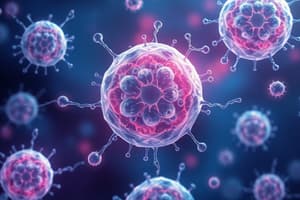Podcast
Questions and Answers
What process do cells undergo to gain new sub-cellular structures to suit their role?
What process do cells undergo to gain new sub-cellular structures to suit their role?
- Meiosis
- Apoptosis
- Differentiation (correct)
- Mitosis
Which type of cells in animals typically only differentiate once?
Which type of cells in animals typically only differentiate once?
- Muscle cells
- Most cells (correct)
- Stem cells
- Nerve cells
What structure do sperm cells possess that helps them penetrate the egg cell?
What structure do sperm cells possess that helps them penetrate the egg cell?
- Acrosome (correct)
- Dendrites
- Flagellum
- Mitochondria
Which feature allows nerve cells to transmit signals over long distances?
Which feature allows nerve cells to transmit signals over long distances?
Which of the following accurately describes muscle cells?
Which of the following accurately describes muscle cells?
How do most plant cells differ from animal cells regarding differentiation?
How do most plant cells differ from animal cells regarding differentiation?
What is the primary function of mitochondria in muscle cells?
What is the primary function of mitochondria in muscle cells?
Which type of specialized cell is known for having many extensions from its cell body?
Which type of specialized cell is known for having many extensions from its cell body?
Which type of cells have the ability to differentiate throughout their entire life?
Which type of cells have the ability to differentiate throughout their entire life?
What is the role of myosin and actin in muscle cells?
What is the role of myosin and actin in muscle cells?
What structural feature of root hair cells aids in water absorption?
What structural feature of root hair cells aids in water absorption?
What is the primary function of xylem cells in plants?
What is the primary function of xylem cells in plants?
How do muscle cells primarily generate energy for contraction?
How do muscle cells primarily generate energy for contraction?
Which feature of xylem cells allows them to withstand the pressure of moving water?
Which feature of xylem cells allows them to withstand the pressure of moving water?
Why do root hair cells contain a large permanent vacuole?
Why do root hair cells contain a large permanent vacuole?
Which process describes how cells become specialized for specific functions?
Which process describes how cells become specialized for specific functions?
Flashcards
Cell Specialisation
Cell Specialisation
Cells change and develop specialized structures to fulfill specific roles or functions in an organism.
Stem Cells
Stem Cells
Cells that retain the ability to differentiate into various cell types throughout their life.
Differentiation
Differentiation
The process by which a cell changes to become specialized, gaining new sub-cellular structures for its specific role.
Muscle Cell Contraction Mechanism
Muscle Cell Contraction Mechanism
Signup and view all the flashcards
Mitochondria in Muscle Cells
Mitochondria in Muscle Cells
Signup and view all the flashcards
Root Hair Cell Specialisation
Root Hair Cell Specialisation
Signup and view all the flashcards
Xylem Cell Specialisation
Xylem Cell Specialisation
Signup and view all the flashcards
Lignin in Xylem Cells
Lignin in Xylem Cells
Signup and view all the flashcards
Cell Differentiation
Cell Differentiation
Signup and view all the flashcards
Acrosome
Acrosome
Signup and view all the flashcards
Nerve Cells (Neurons)
Nerve Cells (Neurons)
Signup and view all the flashcards
Axon
Axon
Signup and view all the flashcards
Dendrites
Dendrites
Signup and view all the flashcards
Neurotransmitters
Neurotransmitters
Signup and view all the flashcards
Study Notes
Cell Specialisation (1.1.3)
- Cells specialise through a process called differentiation. Differentiation involves cells acquiring new sub-cellular structures to fulfil specific roles.
- Cells can differentiate either once early in their development or throughout their entire lifespan. Stem cells are an example of the latter.
- In animals, most cells differentiate only once, but in plants many cells retain the ability to differentiate throughout their lives.
Examples of Specialised Animal Cells
- Sperm cells: Designed for reproduction. Features include a streamlined head and long tail for motility, many mitochondria for energy, and acrosome enzymes to penetrate the egg's outer layer.
- Nerve cells: Transmit electrical signals rapidly throughout the body. Key features are a long axon for signal transmission, branched dendrites for connections with other cells, and numerous mitochondria for energy. Neurotransmitters allow signals to pass between cells.
- Muscle cells (striated): Responsible for rapid contractions to move bones. Contain special proteins which slide over each other, causing the muscle to contract, and many mitochondria to provide energy. These cells can also store glycogen for respiration. Smooth muscle allows variations in blood pressure, for example.
Examples of Specialised Plant Cells
- Root hair cells: Absorb water and mineral ions from the soil. Root hairs increase surface area for absorption. A large permanent vacuole affects water movement, and mitochondria facilitate active transport of mineral ions.
- Xylem cells: Transport water and mineral ions throughout the plant. Lignin deposition in these cells enables them to withstand pressure from water movement through the plant. To conduct water, these cells form tubes by joining together.
- Phloem cells: Transport food produced in photosynthesis to other parts of the plant. Phloem cells lose most of their subcellular structures but still need energy from companion cells' mitochondria to survive. Sieve plates aid transport within the phloem.
Studying That Suits You
Use AI to generate personalized quizzes and flashcards to suit your learning preferences.




